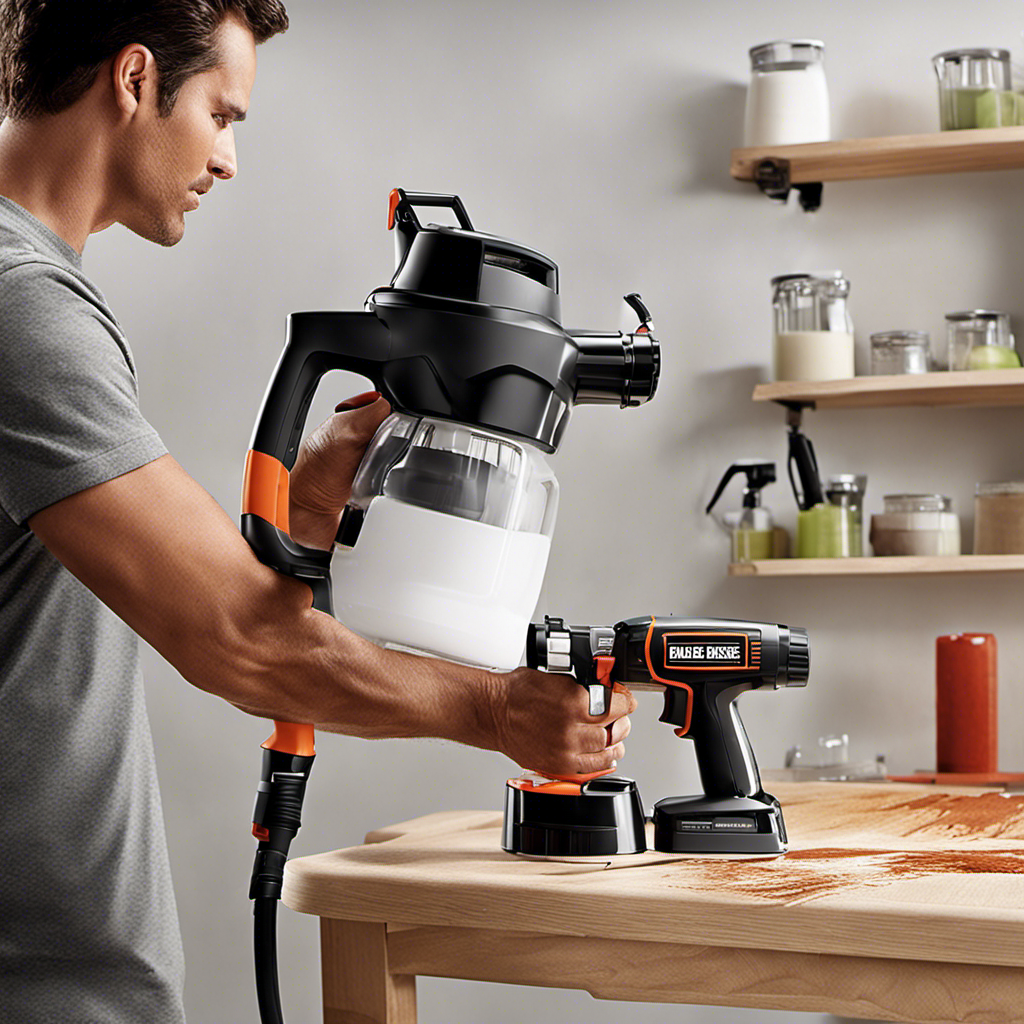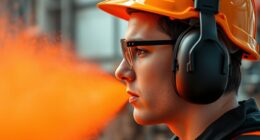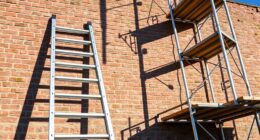Elastomeric coatings provide numerous advantages for stucco walls, such as improved lifespan and resistance to water. Research has demonstrated that the application of multiple thin layers with an airless sprayer can greatly enhance the longevity of stucco walls.
To ensure a professional finish, it is crucial to properly protect surrounding areas and thoroughly clean the surface before applying elastomeric paint. With its ability to expand and contract with temperature changes, this flexible paint prevents cracks and water damage.
By following proper application techniques and accurately estimating paint coverage, stucco walls can achieve a durable and uniform finish.
Key Takeaways
- Elastomeric paint offers a flexible, waterproof seal that helps prevent cracks and water damage on stucco walls.
- It can expand and contract with temperature changes, ensuring long-term durability.
- Applying multiple thin coats with an airless sprayer is recommended for a more durable and uniform finish.
- Properly protecting surrounding areas during the stucco project is important to avoid damage and maintain a professional finish.
Enhanced Durability
Elastomeric paint’s ability to expand and contract with temperature changes ensures long-term durability, making it an ideal choice for stucco walls. The enhanced elasticity of elastomeric paint allows it to withstand the natural movements of stucco walls without cracking or peeling. This is particularly important in regions with extreme temperature fluctuations.
Additionally, elastomeric paint offers excellent impact resistance, protecting the stucco walls from damage caused by hail, heavy rain, or accidental impacts. Its flexible nature allows the paint to absorb the impact and prevent any cracks or dents from forming on the surface. This durability is essential for maintaining the structural integrity of stucco walls and ensuring their longevity.
Consequently, elastomeric paint provides a reliable and long-lasting solution for protecting stucco walls from the elements and potential impacts.
Long-lasting Waterproof Protection
Applying multiple thin coats of this specialized paint can create a long-lasting seal that effectively protects against water damage. Elastomeric paint offers several benefits for roofs, making it a cost-effective waterproofing solution.
Superior Waterproofing: Elastomeric paint forms a flexible, waterproof barrier on the roof surface, preventing water from seeping through and causing damage. It can withstand heavy rain, snow, and extreme weather conditions, ensuring long-term protection.
Durability and Longevity: The elasticity of elastomeric paint allows it to expand and contract with temperature changes, minimizing the risk of cracking or peeling. This ensures that the waterproof seal remains intact over time, providing a durable and long-lasting solution.
Energy Efficiency: Elastomeric paint often has reflective properties, reducing heat absorption and keeping the roof surface cooler. This can help lower energy costs by reducing the need for air conditioning, particularly in hot climates.
Overall, elastomeric paint offers a cost-effective and efficient way to waterproof roofs, providing long-lasting protection against water damage while also offering energy-saving benefits.
Flexible Seal to Prevent Cracks
False
Resistance to Moisture Infiltration
The resistance to moisture infiltration is a key feature of elastomeric paint. This type of paint forms a flexible and waterproof seal on stucco walls, preventing water from seeping through and causing damage. Here are three important benefits of elastomeric paint in relation to moisture resistance:
-
Prevention of mold growth: Elastomeric paint creates a barrier that inhibits the growth of mold and mildew. By keeping moisture out, it reduces the conditions that promote mold formation, contributing to a healthier indoor environment.
-
Energy efficiency: Elastomeric paint can help improve the energy efficiency of buildings. Its moisture resistance properties prevent water intrusion, which can lead to insulation degradation and increased energy consumption. By maintaining a tight seal, elastomeric paint helps to regulate temperature and reduce the need for excessive heating or cooling.
-
Long-term durability: The ability of elastomeric paint to resist moisture infiltration ensures the longevity of stucco walls. By preventing water damage, such as cracking or peeling, it helps maintain the structural integrity of the walls, saving on costly repairs and enhancing the overall lifespan of the building.
Temperature Change Adaptability
Temperature changes can be easily accommodated by elastomeric paint, which expands and contracts to maintain its durability over time. This adaptability to temperature fluctuations is a key benefit of using elastomeric paint on stucco walls. The paint’s ability to expand and contract helps prevent cracking and peeling, ensuring long-term durability and protection against the elements.
In addition to its temperature change durability, elastomeric paint also utilizes advanced paint adhesion techniques to provide a strong bond to the stucco surface. These techniques include proper surface preparation, such as cleaning and priming the walls, as well as using multiple thin coats of paint for even coverage. The table below highlights the benefits of elastomeric paint for stucco walls, including its ability to withstand temperature changes and its superior paint adhesion techniques.
| Benefits of Elastomeric Paint for Stucco Walls |
|---|
| Temperature Change Durability |
| Paint Adhesion Techniques |
Overall, elastomeric paint offers stucco walls the necessary protection and flexibility to withstand temperature changes while maintaining its durability over time. Its advanced paint adhesion techniques further ensure a long-lasting and professional finish.
Smooth and Consistent Surface
Applying multiple thin coats of elastomeric paint with an airless sprayer helps ensure a smooth and consistent surface on stucco walls. This technique has several benefits, including achieving a professional finish.
-
Enhanced Appearance: A smooth and consistent surface provides a more aesthetically pleasing look to stucco walls. It helps to hide imperfections and creates a uniform appearance.
-
Improved Paint Adhesion: A smooth surface allows the elastomeric paint to adhere better to the stucco walls, ensuring long-lasting durability and preventing premature paint failure.
-
Better Protection: A smooth and consistent surface helps to create a tight seal, protecting the stucco walls from moisture infiltration, cracks, and other potential damage.
Improved Paint Adhesion
When painting stucco walls, achieving improved paint adhesion is essential for a long-lasting and professional finish. Elastomeric paint offers a cost-effective option to enhance the adhesion of paint to stucco surfaces.
This type of paint contains special additives that promote better bonding with the substrate, ensuring excellent adhesion and reducing the risk of paint peeling or flaking over time. The elastomeric properties of the paint also allow it to stretch and contract with the natural movements of the stucco walls, further enhancing its durability.
By using elastomeric paint, homeowners and contractors can achieve a strong and reliable bond between the paint and the stucco surface, reducing the need for frequent repainting and providing long-term protection against the elements.
Overall, elastomeric paint is an effective and cost-efficient solution for improving paint adhesion on stucco walls.
Easy Application With Airless Sprayer
Using an airless sprayer for easy application, homeowners and contractors can efficiently apply multiple thin coats of elastomeric paint to stucco walls. This technique offers several benefits and best practices for elastomeric paint application:
-
Efficient and Uniform Coverage: An airless sprayer allows for even distribution of the paint, ensuring a smooth and consistent finish on the stucco walls. It also enables faster application, saving time and effort.
-
Reduced Overspray and Waste: With proper technique and adjustment of the spray pressure, an airless sprayer minimizes overspray and paint waste, resulting in cost savings and less environmental impact.
-
Enhanced Durability and Waterproofing: By applying multiple thin coats, elastomeric paint can provide a flexible, waterproof seal on the stucco walls. This helps prevent cracks, water damage, and ensures long-term durability.
Professional Finish
To achieve a professional finish on stucco walls, homeowners and contractors should pay attention to proper surface preparation techniques.
This includes thoroughly cleaning the walls to remove dirt and debris, repairing any imperfections such as cracks or holes with stucco patching compound, and priming the walls with a high-quality primer.
These steps are crucial for ensuring a smooth and even surface, which is essential for a professional application of elastomeric paint.
Accurate Surface Area Measurement
After ensuring a professional finish, the next step in painting stucco walls with elastomeric paint is accurately measuring the surface area to estimate the paint quantity needed. This is crucial for planning and budgeting purposes.
To achieve this, several measuring techniques can be employed:
-
Measure the height and width of each individual wall, including any windows, doors, or other openings. Subtract the square footage of these areas from the total square footage of the walls to get an accurate measurement of the surface area.
-
Understand the paint coverage rate, which refers to the amount of surface area that can be covered by a specific quantity of paint. Manufacturers usually provide this information. Adjust for multiple coats and texture, as they can affect the paint quantity required.
-
Calculate the amount of paint needed by dividing the total square footage of the stucco walls by the coverage rate. Take into account multiple coats and textured surfaces to ensure sufficient paint for the job.
Calculating Paint Coverage
One can accurately estimate the amount of elastomeric paint needed by calculating the paint coverage rate and taking into account multiple coats and textured surfaces. Estimating paint quantities is crucial for proper paint application techniques. To calculate the amount of paint needed, one should first measure the height and width of each wall to determine the total square footage. Subtract the square footage of any windows or doors from the total. Next, consider the paint coverage rate, which is the amount of surface area that can be covered by a specific quantity of paint. Adjust for multiple coats and texture, as these factors can affect the amount of paint required. Finally, divide the total square footage by the coverage rate to determine the quantity of elastomeric paint needed for the job.
| Step | Description |
|---|---|
| 1 | Measure the height and width of each wall to determine the total square footage. |
| 2 | Subtract the square footage of windows or doors from the total. |
| 3 | Consider the paint coverage rate and adjust for multiple coats and texture. |
| 4 | Divide the total square footage by the coverage rate to determine the quantity of elastomeric paint needed. |
Choosing the Right Quantity of Elastomeric Paint
Calculating the square footage of the stucco walls is essential in determining the appropriate quantity of elastomeric paint to choose. To ensure proper stucco wall protection and effective application of elastomeric paint, consider the following techniques:
-
Measure accurately: Measure the height and width of each individual wall, including any windows, doors, or other openings. Subtract the square footage of these areas from the total square footage of the walls to determine the surface area that needs to be painted.
-
Understand paint coverage rate: Familiarize yourself with the coverage rate of your specific paint, which is the amount of surface area that can be covered by a specific quantity of paint.
-
Calculate paint needed: Divide the total square footage of your stucco walls by the coverage rate to calculate the amount of elastomeric paint needed. Adjust for multiple coats and textured surfaces to ensure adequate coverage and choose the right quantity of paint accordingly.
Thorough Surface Preparation
Thoroughly cleaning and repairing the stucco surface is crucial for achieving a smooth and professional finish when applying elastomeric paint. Before painting, it is essential to clean the stucco walls thoroughly to remove any dirt, dust, or debris that may affect the adhesion of the paint. This can be done by using a power washer or a scrub brush and a mild detergent.
Any loose or flaking paint should be removed using a scraper or wire brush. After cleaning, it is important to repair any cracks or imperfections in the stucco using a stucco patching compound. Allow the patch to dry completely before proceeding.
Once the surface is cleaned and repaired, it is recommended to prime the stucco walls with a high-quality primer. This will enhance paint adhesion and create a smooth surface for the elastomeric paint to adhere to.
Tips for Using an Airless Sprayer
To achieve a smooth and uniform finish, users should adjust the pressure, maintain a consistent distance, and apply multiple thin coats when using an airless sprayer.
Here are three essential techniques for using an airless sprayer with elastomeric paint:
-
Adjust the pressure: Follow the manufacturer’s recommendations to set the appropriate pressure for your specific airless sprayer. This ensures optimal atomization and a consistent application of the elastomeric paint.
-
Maintain a consistent distance: Keep the sprayer nozzle approximately 12 inches away from the surface being painted. This distance helps to evenly distribute the paint and prevents any uneven buildup or streaks.
-
Apply multiple thin coats: Rather than applying one thick coat, it is recommended to apply multiple thin coats of elastomeric paint. This technique allows for better adhesion and creates a more durable and uniform finish.
Maintenance and Inspection for Longevity
Inspecting and maintaining the painted stucco walls regularly is essential for ensuring their longevity and preserving the quality of the elastomeric paint. It is important to follow maintenance best practices to assess the long-term durability of the walls.
This includes conducting regular inspections to identify any signs of damage or wear, such as cracks, peeling, or discoloration. Promptly addressing any issues through proper repairs and touch-ups is crucial to prevent further deterioration.
Additionally, cleaning the walls periodically to remove dirt, debris, and pollutants can help maintain the paint’s integrity and prevent the buildup of harmful substances. Regular assessments of the paint’s condition, such as checking for adhesion, flexibility, and color retention, can provide valuable insights into the overall durability of the stucco walls and ensure their continued protection.
Frequently Asked Questions
Can Elastomeric Paint Be Used on Surfaces Other Than Stucco Walls?
Yes, elastomeric paint can be used on surfaces other than stucco walls. It also provides benefits when applied to concrete surfaces.
Proper preparation is key when applying elastomeric paint on different surfaces. This includes cleaning the surface thoroughly, removing any loose or flaking paint, and repairing any cracks or imperfections. Applying a primer coat before painting is also recommended.
Is Elastomeric Paint Resistant to UV Damage?
Elastomeric paint is known for its resistance to UV damage and its ability to withstand harsh environmental conditions. This makes it an ideal choice for exterior surfaces, including stucco walls.
The paint’s elastomeric properties allow it to expand and contract with temperature changes, ensuring long-term durability. When comparing the durability of elastomeric paint to other paint types, it has been found to outperform traditional paints in terms of longevity and waterproof protection.
Additionally, elastomeric paint has a lower potential environmental impact due to its ability to reduce energy consumption and lower maintenance costs.
How Long Does Elastomeric Paint Typically Last Before Needing to Be Reapplied?
Elastomeric paint typically lasts for around 10-15 years before needing to be reapplied, depending on various factors. The lifespan of elastomeric paint can be influenced by factors such as climate conditions, exposure to UV radiation, the quality of the paint, and how well the surface was prepared before painting.
Regular maintenance and inspections can help identify any signs of wear or damage, allowing for timely touch-ups or reapplication to ensure long-lasting durability and waterproof protection.
Can Elastomeric Paint Be Used to Repair Existing Cracks in Stucco Walls?
Elastomeric paint can be used to repair existing cracks in stucco walls. Its flexible and waterproof properties allow it to fill and seal cracks, preventing further damage.
Elastomeric paint also provides long-term durability and protection against moisture infiltration. By applying multiple thin coats, the paint can expand and contract with temperature changes, ensuring a smooth and uniform finish.
This type of paint is highly recommended for stucco walls due to its ability to repair cracks and provide long-lasting benefits.
Are There Any Special Considerations or Precautions When Applying Elastomeric Paint in Cold or Hot Climates?
When applying elastomeric paint in extreme climates, such as freezing temperatures or scorching heat, there are some special considerations and precautions to keep in mind.
In freezing temperatures, it is important to ensure that the paint is stored and applied at the proper temperature to prevent issues with adhesion and drying.
In scorching heat, it is crucial to work in smaller sections and keep the paint from drying too quickly, which can lead to uneven application.
Proper temperature regulation and working methods are essential for achieving optimal results in these challenging climates.
Conclusion
In conclusion, elastomeric paint is a highly beneficial option for stucco walls. It offers long-term durability and waterproof protection. Its flexibility allows for expansion and contraction with temperature changes, preventing cracks and water damage.
While some may argue that elastomeric paint is more expensive than traditional paint, the long-lasting benefits and added protection outweigh the initial cost. By properly preparing the surface, choosing the right quantity, and using the correct application techniques, stucco walls can maintain a professional finish and withstand the test of time.
Franz came aboard the Paint Sprayer Zone team with a background in both journalism and home renovation. His articulate writing style, combined with a passion for DIY projects, makes him an invaluable asset. Franz has a knack for breaking down technical jargon into easy-to-understand content, ensuring that even the most novice of readers can grasp the complexities of paint sprayers.










